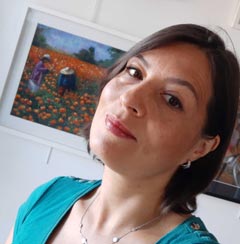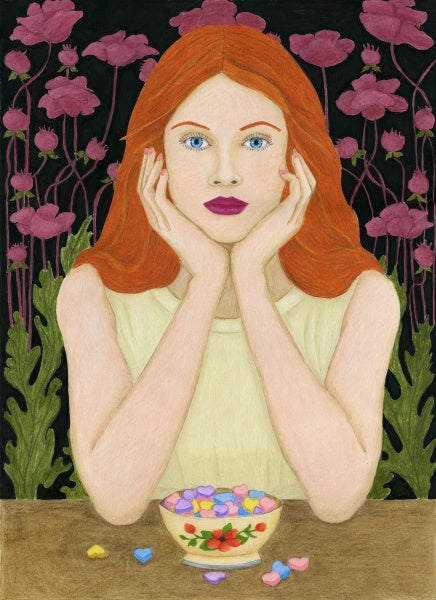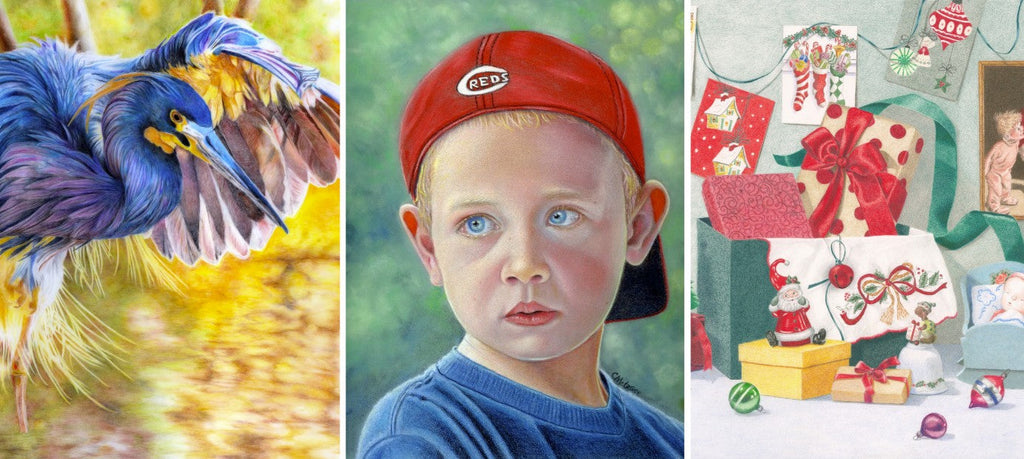"A Plastic Bag" Step-by-Step

by Anne Bour
[Editor's note: We're pleased to be able to share Anne Bour's tutorial with you here in our blog. For a reference photo and line drawing download, click here.]
Having discovered the many possibilities of drawing with colored pencils — which allow me to bring to life textures such as fabric, metal and animal fur — I more recently realized that plastic could be an interesting subject to draw. That is why I would like to introduce you to my abstract way of drawing realistic plastic subjects with colored pencils.
Materials:
- Faber-Castell Polychromos: Warm Grey VI, Cold Grey IV, Warm Grey I, Rose Carmine, Magenta, Middle Purple Pink, Pink Madder Lake, Alizarin Crimson, Manganese Violet, Salmon, Light Magenta, Black, White.
- Faber-Castell Albrecht Dürer: White
- Derwent Lightfast: Mars Violet
- Pablo Caran d’Ache: Light Grey
- Paper: Clairefontaine Pastelmat Paper (Gray)
- Caran d’Ache mechanical sharpener
- Kneaded eraser
Step 1:

After I have placed the line drawing on the Pastelmat paper with a pencil (or a pink pencil) I take care not to mark the first lines too heavily. I then very softly start with the main dark shadows of the bag to sharpen the outlines and bring out the form of the bag. I then apply some layers of a semi-sharp Warm Grey VI and Black pencils to the handles of the bag, as well as along the right side and the bottom. Next, I apply Cold Grey IV to blend the three colors together. Now, I can clearly see the general shape of the bag, so I continue to add the first range of pink colors on the stripes, pressing a little with Rose Carmine. Then I choose Magenta, always pressing softly in the darker parts of the pink stripes. At the same time, I press more firmly on the darker parts of the folds of the handle with the same color, as you can see in the first picture.
Step 2:

Using Magenta, I continue to fill in the pink stripes of the entire bag. For the moment, I only add a base to the white stripes with Derwent Mars Violet. This color is very light, so you can add it to every white stripe. Note that it is best to start with a base color followed by dark colors and midtones, ending with the lighter tones because of the color of the grey and neutral Pastelmat paper I chose. I add Magenta to delineate the folds without pressing too hard with the pencil. The color is laid down without clearly marking the edges of the stripes so as to avoid hard lines; the realistic nature of the bag will be achieved through various pressures, and with pencils that are not too finely sharpened.
Step 3:

For this part, I continue to accentuate the pink stripes with more saturated colors. I add Middle Purple Pink lightly to the darker parts and Pink Madder Lake to the parts between the dark and light bands to better separate them. I do not yet press down heavily with the tip of the pencil; I choose not to sharpen my pencils, as this allows for softer and more delicate strokes. I work on the white stripes with the Magenta I used in the darker parts of the bag (Step 1), and I also add into dark folds which form as result of the pink stripes, the two of which should touch. By this I mean the outlines that separate the two colors of the pink and white stripes.
Step 4:

I return to the pink stripes to begin working on the midtones with Manganese Violet and Alizarin Crimson to bring warmth to the folds of all of the stripes, both pink and white. The Manganese Violet will serve to warm up the parts of the drawing which will make certain sections of the stripes appear transparent, because it is important to remember that the bag consist of two layers: the back of the bag which we do not see, and the front which we do. You can see this effect at the top right corner of the bag, where a single layer is visible.
Step 5:

Now, I move on to the white stripes. Here it is important to keep in mind that the White cannot be too starkly vibrant, so as to avoid any artificiality. First of all, I add Pablo Light Grey, because it is pale, but not too pale. This allows us to use soft pencil strokes which do not score the paper. This gray is added after the Mars Violet we used at the beginning, and then I add Warm Grey I to the light parts of the folds, using a little bit everywhere to blur the shades and give the drawing a realistic feeling. l finally add the White after the gray tones and only in the really light parts of the folds by pressing well with the pencil. Because Warm Grey is very a light tone, I start with the Light Grey Pablo before putting in the highlights.
Step 6:

For this step, I look at the different sections of the bag in a general manner, so as to avoid making harsh lines appear as I add the lighter colors. Note that the plastic is similar to the folds in aluminum foil; for example, they are often triangular in shape, and we must bring these out to create a more realistic drawing. I bring out the pink stripes by adding the following colors: Pink Carmine, Salmon and Alizarin Crimson. Pink Carmine and Salmon are the transitional colors of the darker part and the midtones to the lighter and final tones of the whole drawing.
One must carefully observe the different shades of the bag to reproduce a part of it in the drawing. Of course, I cannot (and in fact do not want to) become too focused on detail, as my drawing is rather small, and its size does not lend itself to excessive detail. I bring out the dark colors, using Pink Carmine for some sections and Alizarin Crimson or a similar red which is neither particularly pale nor dark, to lightly go over the folds, bring some warmth to the pinks, and most importantly to separate the white stripes from the pink ones. For the very light parts of the folds, I add White to enhance the lighter pink shades which I laid down previously.
Note how I make the transition from the dark to the light colors. The pencils blend better when I go from dark to light than when I do the opposite. White is laid down last, and at this point, the well-sharpened tip of the pencil can be pressed into the paper when necessary. The sharper point allows me to better set down the pale shade in a marked manner, but without making harsh, straight lines.
Step 7:

The final step consists of placing the lighter shades in the luminous parts of the white stripes. I use White, Light Magenta and Warm Grey VI. I use the gray to accentuate certain sections which require the appearance and the translucence when necessary. Light Magenta will balance the darker shades in the folds, and will make it appear transparent. Using a well-sharpened White pencil, I will accentuate the place where light hits the folds in the same manner as I shaded the pink stripes, making sure not press down too firmly while accentuating the folds which light hits the most. In certain areas, I add pencil strokes which I crosshatch in several directions to create the smaller folds in the bag which cannot be drawn in too much detail; here, a softer gaze will help bring the composition together.
Very often when I am drawing with white, I use a white pencil from a brand which uses a soft lead, and then I use Faber-Castell’s White with a harder lead in the later stages of the drawing. Another option would be to use White Faber-Castell Albrecht Dürer. Combining two shades of White Aquarelle and Faber-Castell Polychromos is a good compromise, and allows one to blend the white well to achieve a more realistic drawing. As for the last step, I look carefully at the stripes, making sure that they are well-separated by shadow and light rather than harsh lines. Last, of course, I look at the piece as a whole, making any small adjustments as necessary so as to create a balance between the different shades that make up the plastic bag.

Anne is a French and Mexican artist who always has learned drawing and painting from French and foreign artists she admires. Since 2015, Anne has taught drawing, colored pencils and soft pastel techniques online and in her workshop in France where she exhibits her artwork. See her on Facebook and YouTube.




